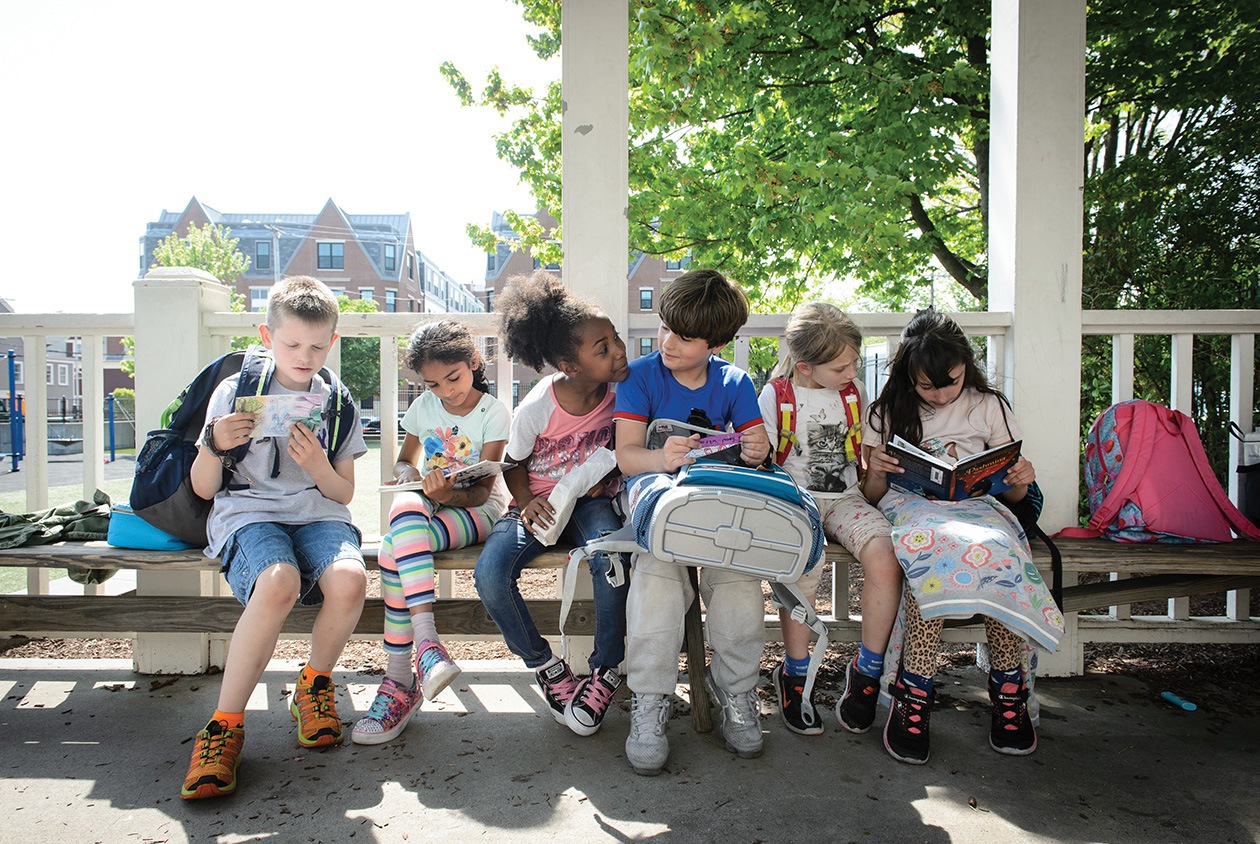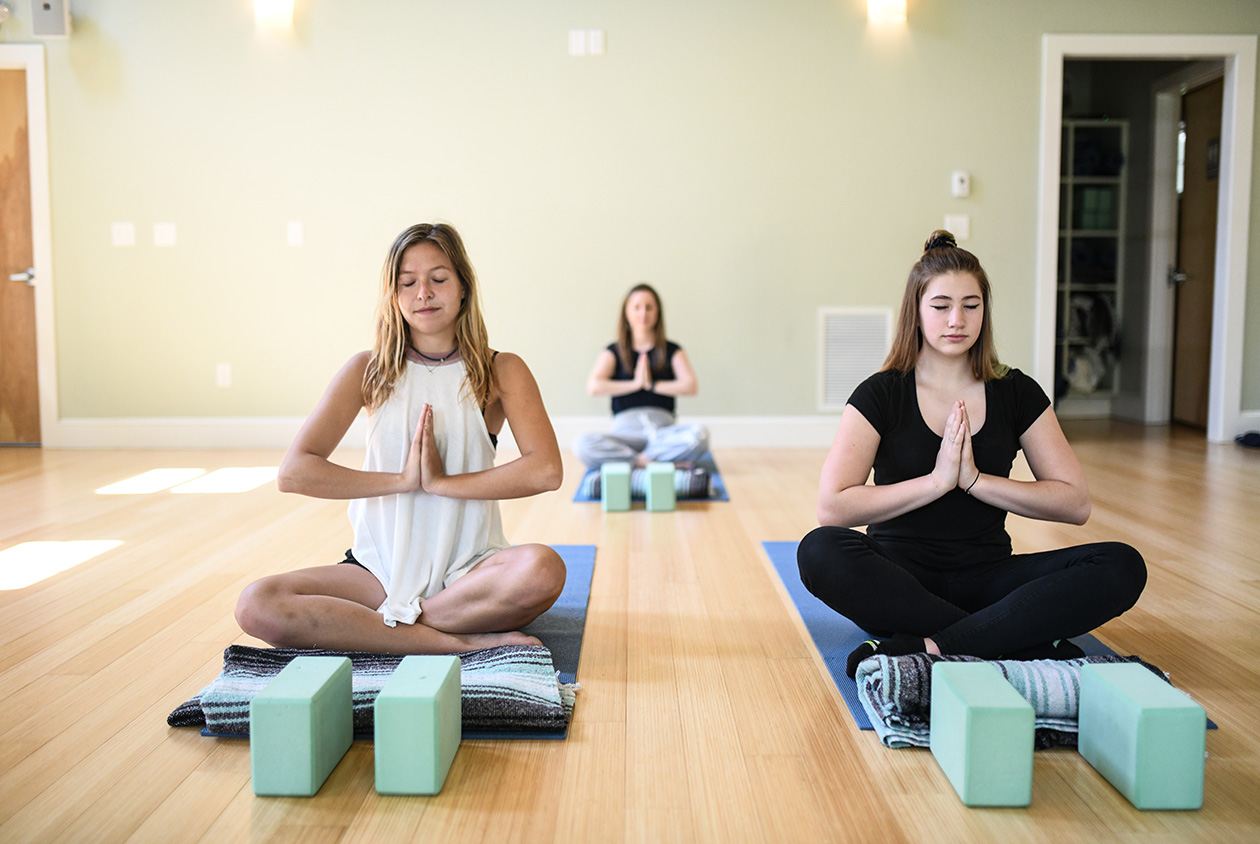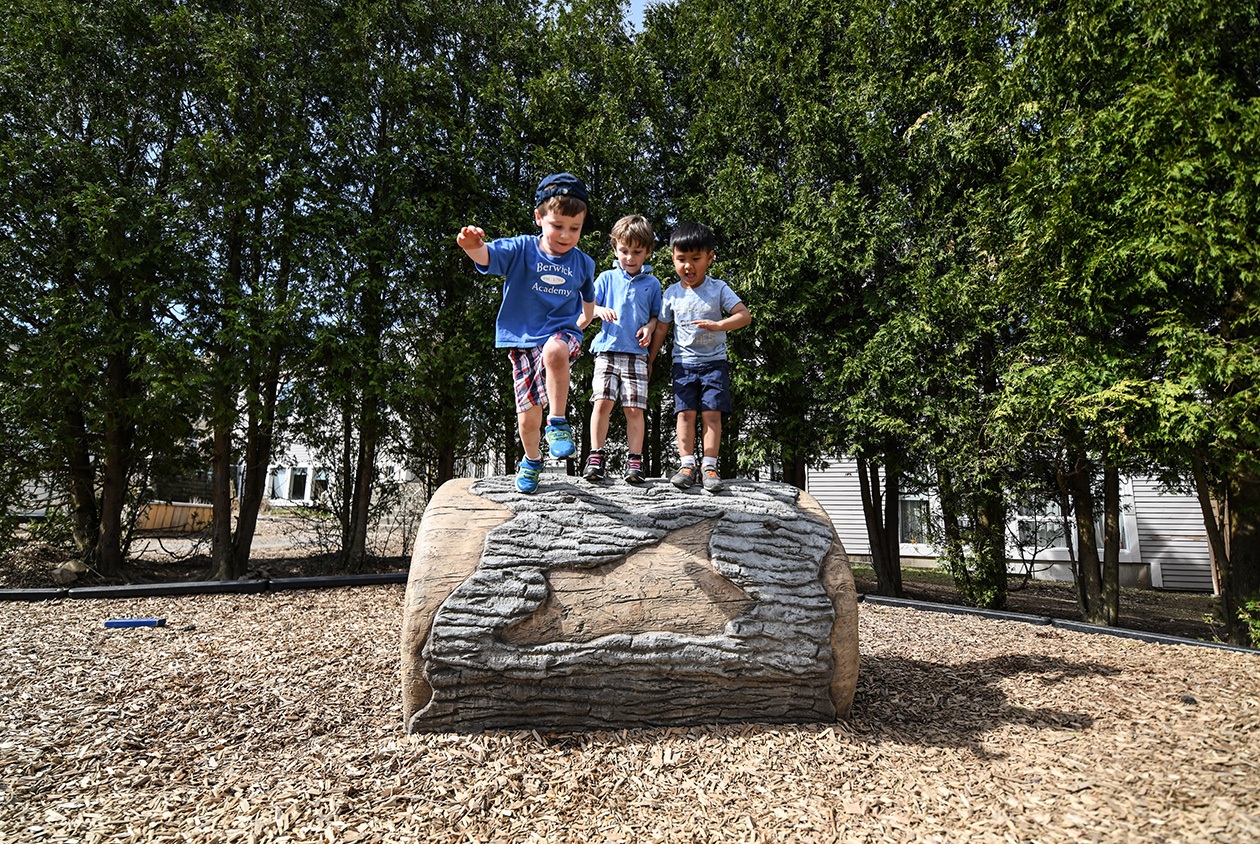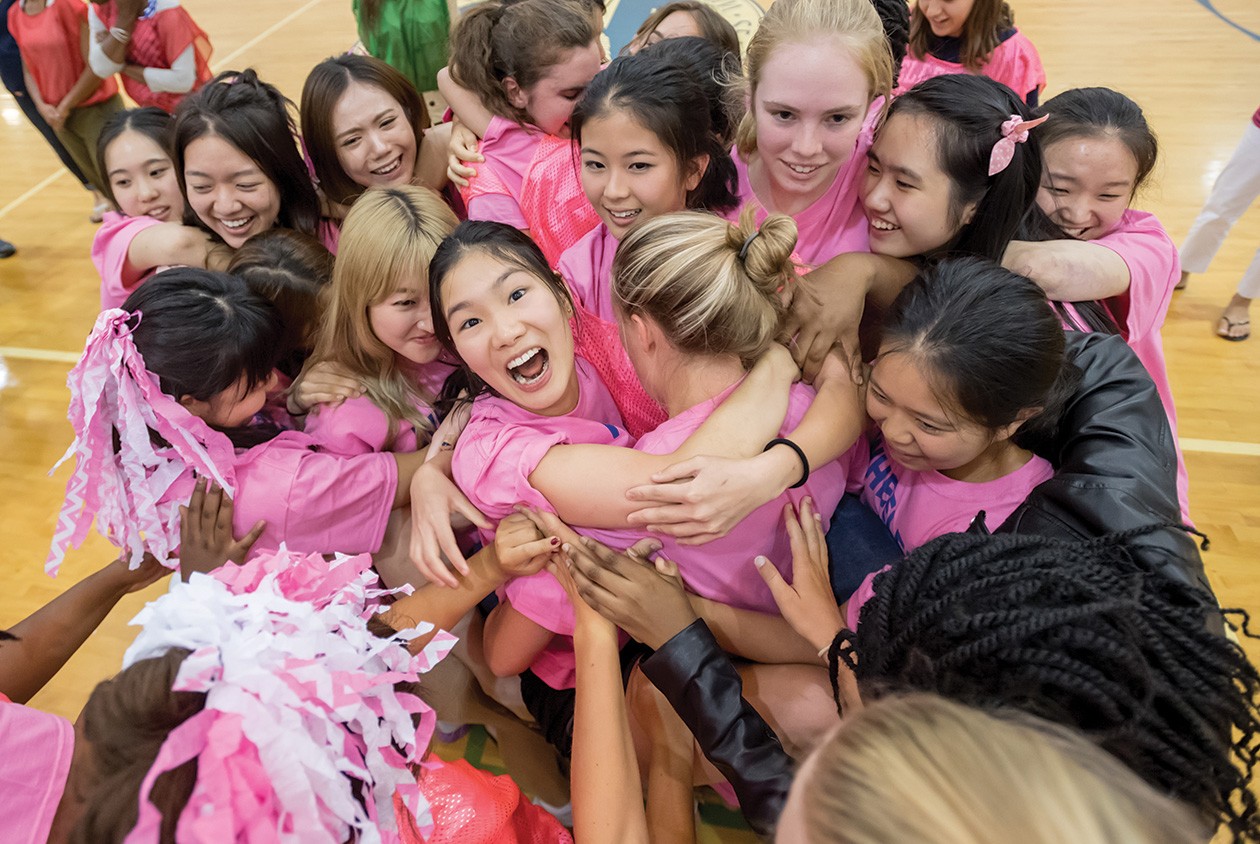What is the Independent School Advantage?

Photo credit: The Wheeler School
More than 200 schools come together in membership in the Association of Independent Schools in New England (AISNE). These schools each have a unique story and mission, yet every one of them is guided by a central and unifying goal: to create environments in which children’s varied and diverse needs, backgrounds, and interests are celebrated as they are prepared to be empowered citizens in an increasingly global and complex world.
Classroom innovations
The bedrock of what independent schools offer are exceptional educational experiences, and that means constant re-evaluation of how to apply best practices to what teachers are seeing in the classroom. Mark Harris, director of the Aerie Program at The Wheeler School in Providence, Rhode Island, has been challenging himself to provide the best possible education for his students for more than four decades. Harris was initially inspired to innovate in the classroom when he saw how excited younger students were to learn. “It struck me that the excitement that youngsters have for learning should be key throughout a student’s school experience,” Harris says. “Wheeler has made nurturing that excitement an essential part of its mission, from the preschool program through high school.”
He also observed that not every child in the same classroom responded the same way. Differentiated learning styles were especially pronounced for extremely bright children. “It seemed better for a school to adapt to a student’s natural interests, rather than to force a child into a standard mold,” says Harris. The Aerie Program was created to respond to the unique needs and interests of each of Wheeler’s students. The program provides both classes and extracurricular enrichment opportunities, inspired by the students themselves. At the same time, The Wheeler School also wanted to better serve students with dyslexia, and eventually formed The Hamilton School, now one of the leading programs in the country for teaching dyslexic students. It didn’t take long for all of Wheeler’s teachers to realize that every one of their classrooms had children who need individualized instruction. As a result, teaching in every division of the school has changed to be responsive to individual students as soon as possible. “‘One size fits all’ is not the way school works anymore,” he says. “At least not here.”
For many schools, innovation is also a response to an increasingly sophisticated technological environment. “In a world where you can now look up just about any fact known to humankind in three seconds on your cell phone, what’s the point of school?” Matt Glendinning, head of school at Moses Brown School in Providence asks. “It’s clearly not to amass more and more factual information.” Instead, Glendinning believes that the answer is to give students opportunities to apply their knowledge to real-world questions that demand creative solutions.
In addition to asking students to stretch beyond passive learning, this philosophy also demands more flexibility from instructors. When Moses Brown teacher Elizabeth Grumbach began incorporating project-based learning into her classes and developing makerspaces for them, one of the first observations she made was that she had to let go of some control in order to maintain her students’ initial enthusiasm. She advises teachers who want to allow children more creativity not to panic when they come up with solutions you hadn’t thought of. “It’s important to let them get excited about ideas,” she says.
While Grumbach’s classes have access to cutting-edge technology, her challenge is to find projects that allow students to actually use makerspace equipment and not just watch her use it. Because the technology is always evolving, and much of it requires complex software mastery, Grumbach has had to think creatively about which pieces of equipment best lend themselves to a class’ developmental abilities. This fall, she is excited about having her third-grade students wrap up a unit on water and water conservation by learning how to design and produce water-saving projects using the school’s laser cutter.
A commitment to innovation can also lead to surprising breakthroughs. Grumbach says supporting group dynamics is more important to project-based learning than providing gadgets. The most successful projects are going to be those in which students not only offer ideas but “listen and seek out other students’ ideas.” This can be a challenge in a classroom that combines extroverts and introverts. Some of Grumbach’s solutions include a brainstorming process that allows everyone 10 minutes to write their initial ideas in silence before beginning an open discussion, and regular moments for self-reflection. To drive home the importance of diversified contributions, Grumbach also asks everyone to identify an idea that someone else offered.

Photo credit: Berwick Academy
Foundations of wellness
Tuning into the subtleties of children’s needs in and out of the classroom is also part of a growing focus on advancing wellness. As a complex world has become more accessible to younger children, it’s more important than ever to ensure academic needs aren’t the only needs being met. The Health and Wellness Program at Belmont Day School was initiated 10 years ago as a grassroots effort by a group of faculty, administrators, and parents. After researching several programs and not finding one that fit all of their needs, Belmont Day School developed their own.
According to Belmont Day Head of School Brendan Largay and his wellness team, it’s important to teach not only the facts about wellness, but also the context. “All students need to see the world as it is truly reflected,” says Largay. “A world that is multi-gendered, multiracial, multicultural, with a variety of sexual identities and a variety of perspectives.” The results of the program may be their best advertisement. “[Our] students are comfortable discussing a variety of health and wellness topics openly and honestly, including identity, family configuration, diversity, reproduction, values, and personal choices,” says Largay. Additionally, Belmont Day School graduates report being better informed about health and wellness topics than their peers, and better able to make more informed choices.
For Berwick Academy in South Berwick, Maine, balance has always been a core value, and that translates into three pillars of wellness: movement, health and nutrition, and resilience. Berwick’s wellness programming includes everything from integrating yoga in the lower school classrooms to a mandatory weekly non-academic activity period. Faculty and staff actively monitor and guide the social dynamics in the middle school and regularly assess each upper school student’s social and emotional health alongside their academic progress. The results have been encouraging. “At a time when anxiety and depression are on the rise in our society, we are encouraged to see an increased ability in our students and faculty to recognize and verbalize when they need downtime or have wellness needs,” says Jim Hamilton, head of school at Berwick. “There is a real awareness of the importance of place, the value of empathy, and the need for reflection in our students.”
The Middlesex School in Concord also stresses the importance of empathy, both in and out of the classroom. Director of MxGlobal Rob Munro and his team spent two years developing Dialogues Across Differences, a new Middlesex graduation requirement in which the goal is to build understanding and help students navigate life in a world where divisive opinions and hostile interactions are more normalized than ever before. Over the course of this six-week program, students learn and apply a set of skills designed to help them put others’ perspectives into context. The work doesn’t stop in the classroom. According to Munro, “students [now] have the opportunity to implement the skills learned in this class throughout their Middlesex experience,” including residential life and athletic and leadership roles.
Teaching empathy also serves the commitment to diversity that is a foundational value for many independent schools, as well as for AISNE. The Meadowbrook School of Weston is intensely focused on creating an inclusive, equitable, and diverse environment. An educational commitment, as well as an ethical one, Meadowbrook Head of School arvind grover says, “If you want a vibrant learning community, you need a diverse one.” According to grover, a diverse learning community is one that demands its members stretch its beliefs the most and “makes you work hard in a great way.” In order to create that environment, he says, “All students should feel connected, comfortable, and respected.”
Meadowbrook’s commitment to diversity and inclusion extends beyond the school’s active recruitment of a diverse student body. The school strives to foster an environment in which every student feels truly welcome. This is achieved, in part, by having what are often difficult conversations about race and class. As they do their students, the administration continually pushes itself to make sure they are uncovering the evolving needs of their community. In some cases, this means designing new initiatives, such as a fund established to ensure all eighth-grade students participate in a cultural immersion trip to Costa Rica that focuses on community service and environmental stewardship. In other cases, equity is supported through more subtle cultural shifts, such as not putting focus on how students spent their summer vacations, or by assigning seats which require each student to mix with new teams and partners.
For Moses Brown School, social justice is an inherent part of its mission. In addition to encouraging student-led activism, the school offers several programs designed to inspire children to think critically about all aspects of social justice. “The Economics of Social Innovation,” a semester-long course taught by interim Head of the Upper School Gara Field and math teacher Dan Ohl, required students to connect with local entrepreneurs and business people of socially conscious enterprises to help create solutions to real-world problems. The class wanted to find a way to help food insecure school-aged children in Rhode Island’s urban core. Their answer was to create Food From Friends, a nonprofit which would collect surplus food from supermarkets and redistribute it to children in need. “[Students] sought out a real-world audience who could make their idea a reality,” says Field. Among the attendees were Rhode Island first gentleman Andy Moffit, General Treasurer Seth Magaziner, and Moses Brown Head of School Glendinning, all of whom were impressed enough to accept an invitation to join Food From Friends’ board of directors.
For some independent schools, social activism is a founding principle. The Advent School in Boston, founded in 1961, embraced the challenges and discussions borne of the civil rights movement, for both their school and their students. Advent Head of School Nicole DuFauchard says, “Kids are amazing, super astute, and observe everything.” That’s part of the reason why their elementary school curriculum includes social justice activism. In every class, historic and ongoing social issues are incorporated into the curriculum, whether it’s factory economics or water science. Because many students living in urban areas frequently see homelessness and inequity up close, they have initiated their own advocacy projects, including a mitten tree for the homeless that was inspired by a kindergarten winter outing. “At seven, they know they can’t change the whole world, but they can change it a little bit,” DuFauchard says.

Photo credit: Berwick Academy
Weighing the costs and benefits
Given the elephant in the room during any conversation about independent schools is often times the cost, some may be surprised by this intense focus on social justice and equity. However, the majority of these schools have long traditions of providing financial aid to families for whom an independent school education would otherwise be out of reach. According to a 2017 survey by the Enrollment Management Association (EMA), almost 60 percent of the families applying to independent schools apply for some form of financial aid.
Angela Brown, director of enrollment management and marketing at Dana Hall School in Wellesley, stresses that numbers don’t tell the whole story about financial aid. As tuition costs have increased, so has the percentage of operating budgets devoted to aid, both for tuition and additional expenses, such as transportation, technology, and academic travel. Given the majority of schools are largely tuition-funded, Brown considers this percentage to be an important indicator of a school’s commitment to financial aid. “How you spend your time and money shows what you value,” Brown says.
In spite of the costs, thousands of families make the decision every year to send their children to independent schools. Not surprisingly, many families feel these schools provide a level of academic rigor not available elsewhere. Indeed, 97 percent of families surveyed by the EMA cite academics as the most important factor in their decision to explore independent schools. Nearly equally weighted, 92 percent of them rate the development of strong moral character as a motivation to attend an independent school.
Perhaps the best indicator of the value of an independent school is in the character of its graduates. “Schools love [Meadowbrook] kids because they are academically prepared and they’re able to contribute to their new communities in a plethora of ways,” says grover. Because they’ve already been exposed to difficult discussions about class and race, they’re ready to have those conversations in their new schools and “frequently push their new environments to be better.”
For Advent alumni, a natural progression from advocating for others has been speaking up for themselves. “[Our alumni] always feel they have a voice, even in larger environments — whether that’s speaking out when they see injustice or to advocate for their own education,” DuFauchard says.
If you’re seeking to immerse your child in an educational experience devoted to applying the latest innovations in teaching and learning, while also encouraging students to deeply understand both themselves and others, visit aisne.org or search our Find It database today!

Photo credit: Dana Hall School
Deborah Nam-Krane writes for The Lazo Group, a full-service virtual marketing agency that provides scalable, innovative, and customized solutions to achieve clients’ goals. The Lazo Group interviewed AISNE member schools for this story.
This is a paid partnership between Association of Independent Schools in New England and Boston Magazine

